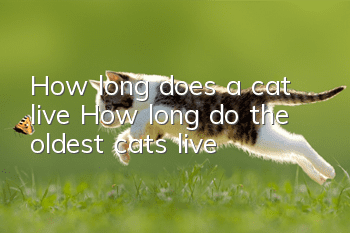How long does a cat live? (How long do the oldest cats live?)

Do you know how old the oldest cat in the world is? According to Guinness World Records, the first place is Clem Puff of Texas and is listed as the oldest cat in the world. Clem Puff was born on August 3, 1967 and died in August 2005, aged 38 years. The second place was a cat born in 1903. He lived until November 29, 1939, the day after his 36th birthday. The cat passed away. The third place is Grampa, who lived to the age of 34. Looking at it this way, you may think that a person in their 30s does not live a very long life, but if you convert a cat’s age into an adult’s age:
Your cat’s first year of life is equivalent to 15 human years.
Then, the second year of the cat plus 9 years equals the number of human years. For example, a 2-year-old cat is roughly equivalent to a 24-year-old human.
Next, your cat will add 4 years to the original base every year to equal human years. For example, the third year is equal to 24+4=28 years old, the fourth year is equal to 32 years old, and the fifth year is equal to 36 years old. .
The oldest cat in the world lived to be 38 years old, which is equivalent to 168 years old in humans! The average life span of humans is only 53-77 years old, so a 38-year-old cat is really super long-lived!
The average life span of a cat
So, how long is the average lifespan of a cat? Statistics show that indoor cats live much longer than outdoor cats. Because outdoor cats, including stray cats, are often at higher risk of illness, car accidents, and injury or death from other animals or humans, outdoor cats have a lower life expectancy.
The average lifespan of outdoor cats is 4-5 years, but many stray cats may not survive their second year of life. The average lifespan of indoor cats is 9-15 years. Improvements in nutrition, advances in veterinary care, and a trend toward more scientific cat ownership mean that the average domestic cat is living longer.
How to make cats live longer?
There are many ways we can extend a cat’s life:
1. Nutrition is very important:
Feed your cat high-quality and balanced food according to the age of the cat. For example, kittens need to be fed kitten food, not adult cat food. Otherwise, it will lead to slow development at best, malnutrition, anemia, and even Disease etc.
2. Regular vaccination:
Vaccines can prevent severe infectious diseases and are very important. Regarding vaccination, if you are interested, you can click: 5 key points that you need to pay attention to when cats are vaccinated (Things to note when cats are vaccinated)
3. Keep your cat healthy:
This includes regular deworming and regular physical exams (at least once a year), which are vital to your cat’s health and early detection of disease and health problems.
4. Monthly health check:
In addition to taking the cat to the hospital for a professional physical examination, you should also pay attention to the cat's health at home. You need to observe whether the cat has other changes, such as loss of appetite, increased thirst, lethargy, behavioral changes, and changes in defecation habits. Blood in the urine, loose stools, infrequent bowel movements, rapid weight loss or gain, lumps and bumps, non-healing wounds, and more.
5. Oral health care:
The impact of unhealthy teeth and gums on the body goes beyond bad breath, to pain and infection. Since the gums have a rich blood supply, once infected, bacteria can easily be transported to other organs (such as the liver, kidneys, etc.) causing damage or even organ failure.
6. Genetic diversity:
Non-purebred cats tend to live longer than purebred cats, with an average lifespan of 14 years compared to 12.5 years for purebred cats. This is because "Chuan Chuan" genes are more abundant and the chance of genetic diseases is less.
Signs of aging in cats
So, what are the signs of aging in cats?
① As they age, your cat may become less playful and spend more time sleeping.
② Weight loss is quite common in older cats; common causes include diabetes, hyperthyroidism, kidney disease, and cancer, which are all common diseases that can affect middle-aged to older cats.
③ Arthritis is a common disease with symptoms including limping, reluctance to put weight on one leg, stiffness, and reluctance to jump. Besides these signs, there are many more.
In short, how long is a cat’s lifespan? A big factor may depend on how we raise it. Nowadays, not only people need to keep in good health, cats also need to keep in good health.
- Why do cats scratch people? Why do cats like to scratch people?
- Why You Can’t Raise Yellow Cats Four Reasons Why No One Raise Yellow Cats
- What should cats eat to replenish their health after giving birth to kittens?
- What does it mean when a cat's tail twitches?
- What should I do if my 3-month-old kitten still has soft stools after being dewormed? Popular science on cats!
- What to do if a cat falls from a building
- Why does a Siamese cat have diarrhea after drinking water?
- Does Jinji need to trim the hair on his butt?
- How to bathe a cat when spring comes
- What should I do if my female cat urinates indiscriminately at home? How should I solve it?



